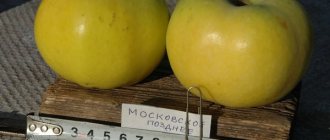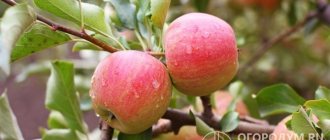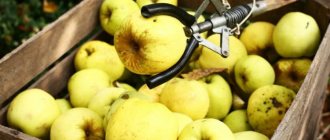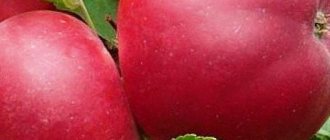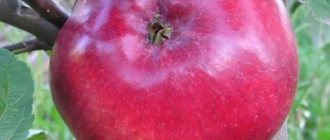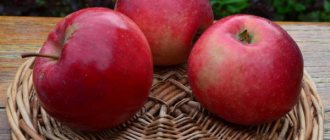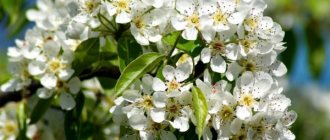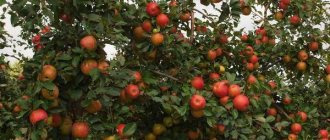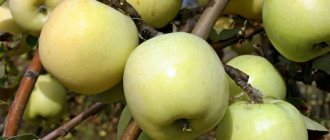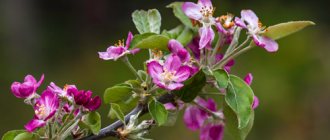Description of the Moscow Winter variety
Many gardeners believe that winter apples are exclusively green.
These apples with their appearance prove the opposite.
Apple trees of this variety are very tall. Their crown is thick and round in shape. The branches are mostly located horizontally.
Young shoots are not thick, brown in color. The leaves are quite voluminous and dark green in color. The leaf blade is strongly wrinkled and highly pubescent.
The edges of the plate are heavily jagged. Inflorescences are medium size, pink.
The color of the apple is green, but as it ripens, a pink blush appears. The fruits are quite large and round in shape. The ribs are not pronounced.
The skin is medium thick, smooth to the touch. Small subcutaneous dots are visible across the entire surface of the apple.
The seeds are small, closed seed chambers. The saucer is medium size, flat. The funnel is shallow, slightly brown around the edges. The pulp is sweet and sour, dense, white.
History of selection
The Moskovskoye Zimneye apple tree variety was obtained at the Moscow State University. M.V. Lomonosov in 1963. The development of the new variety was carried out by S.I. Isaev.
Apple trees of this variety were obtained by crossing the Welsie and Antonovka vulgaris varieties. To conduct the experiment, 15 trees of the mother variety, over 10 years old, were selected.
Antonovka vulgaris acted as the father variety. During hybridization, the maternal variety, Welsey, was pollinated twice by the paternal variety. Both pollinations were successful, and the breeder was able to collect seeds of the hybrid variety.
Before further planting in the ground, the seeds were stratified from February to March. The seeds were planted in the ground under harsh conditions to give the new variety frost resistance.
The seedlings of the new variety were cared for using the mentor’s method.
additional characteristics
Advantages and disadvantages
The Moscow winter apple tree, like any other fruit crop, has its advantages and disadvantages. The positive characteristics of the variety include:
- Frost resistance;
- High yield;
- Valuable qualities of fruits;
- Immunity to scab.
The disadvantage of the plant is the late onset of fruiting.
The Moscow winter apple tree is valuable for its fruits.
Zoning
In 2002, the variety was zoned in the Moscow region. Then, thanks to its high frost resistance and good yield, the fruit crop spread to many regions of Russia and Ukraine.
Dimensions of an adult tree
Due to the horizontal, wide skeletal branches, the apple tree has a round, spreading crown. The tree is quite vigorous, 9–10 meters in height , with a straight gray trunk. The foliage is light green, wrinkled, with pointed edges, slightly drooping towards the bottom.
Annual growth
The fruit crop is quite vigorous . The annual growth of the central conductor and branches is about 10 cm or more.
More on Tele4n.Net:
Columnar apple tree President. Description of the variety, characteristics, planting and care, reviews
Moscow winter grows by 10 cm per year.
Periodicity in fruiting
The apple tree has a high annual yield , but with age, periodicity may occur.
Productivity
With proper care and proper pruning, the tree can produce up to 160 kg of fruit.
Tasting assessment
Apples weighing 200 - 300 grams, correctly round in shape . The fruits are green, but during storage they acquire a yellowish tint. The pulp is dense, fine-grained, juicy, sweet and sour. According to the tasting assessment it is 4.5 points.
Fruits of the Moscow winter apple tree.
Vitamin content in fruits
Apples of the Moscow Winter variety are valued not only for their taste, but also for their beneficial qualities. For 100 gr. fruits account for:
- Titratable acids – 80%;
- Ascorbic acid – 20 mg;
- Pectin substances – 8%;
- Tannins – 70 mg;
- P – active substances – 8.5%.
Apples also contain a large amount of vitamins such as A, B, C, E, PP.
Winter hardiness
The fruit crop is highly winter-hardy. In winter, at minus temperatures of 35 degrees, a tree rarely freezes.
The Moscow winter apple tree can withstand 35-degree frost.
Important! The tree does not tolerate spring frosts well.
Disease resistance
The variety has good immunity to powdery mildew and scab . But gardeners must be prepared for diseases such as fire blight and cytosporosis when growing apple trees on their site.
Moscow winter can be affected by cytosporosis.
Watch a video about fire blight:
Region of natural growth and features of adaptation in other regions
The region of natural growth of the Moscow winter variety is central Russia. The variety was specially bred to grow in this region, but due to its frost resistance it also adapts well to regions with colder climates.
If the variety grows in drought conditions, then abundant watering is needed for its rapid adaptation. Since apple trees absorb nutrients from the soil in dissolved form, they love loose and moist soil.
If there is a lack of moisture, the apple tree cannot accumulate the required amount of nutrients, which can lead to depletion of the apple tree.
In harsh conditions, the soils are quite poor and there are few nutrients in them. Therefore, when adapting a variety to cold conditions, it needs to be provided with regular fertilizing .
For the fastest adaptation of a young seedling, fertilizing should be done 2 times a year. In winter, the ground around the seedling should be well covered with leaves so that the roots of the young apple tree do not freeze.
Protection
The apple tree is quite frost-resistant. However, it should also be protected from early frosts and snowy winters.
Wrap the trunk with covering material or old nylon tights.
The material must allow water and air to pass through itself. It is not recommended to use film or roofing felt!
To combat pests like mice and hares, use the same nylon tights, or better yet, rodent nets.
The trunk circle is necessary when growing an apple tree. It is required to keep it clean from weeds and loosen it every day.
To improve the winter hardiness of the tree, it is permissible to mulch with horse humus in a layer of up to 5 cm.
Productivity
The Moscow Winter variety is a high-yielding variety . This variety will bear its first fruits 6 years after planting. The harvest volumes are quite high; when grown in favorable conditions, about 80 kilograms of apples can be harvested from one tree.
This variety bears fruit every year, but as the apple trees age, the frequency of fruiting decreases. The weight of a mature fruit is 120 grams.
Collected apples retain their characteristics for a long time. This variety is ideal for sale.
Pests and diseases
Apple trees of the Moscow winter variety practically do not get sick . They are slightly susceptible to scab. Due to improper care, diseases such as:
- Cytosporosis . The fight against cytosporosis must be comprehensive. Before the buds swell, the apple tree should be sprayed with Hom, and before flowering with a solution of copper sulfate.
- Bacterial burn . The first aid to a tree with a bacterial burn is to destroy the lesion. Affected branches must be removed and the apple tree itself disinfected.
- Black cancer . When fighting black cancer, damaged branches must be trimmed and damaged bark must be removed. The resulting wounds need to be healed and the tree disinfected.
Pests can destroy not only the crop, but also the apple tree itself. Basic pest control measures:
Green aphid
. To kill aphids, you need to spray the tree with tobacco infusion or a solution of laundry soap.- Apple moth . Spraying the tree with a chlorophos solution can destroy this parasite.
- Leaf roller . This insect primarily damages the leaves. Only a nitrophen solution can cope with it.
- Apple flower beetle . To preserve flowering and ovary, the apple tree must be sprayed with a solution of karbofos or chlorophos.
To summarize, we can say that Moscow winter apple trees are ideal for industrial breeding.
This variety is very often found on store shelves, as its long shelf life and marketable appearance make it very profitable for sales.
If you find an error, please select a piece of text and press Ctrl+Enter.
Planting and care
In order to turn your apple tree into the center of the garden, you need to regularly care for it.
Apple trees of the Moscow winter variety are quite easy to plant. They are unpretentious to the place where they grow, but still the most suitable place for apple trees would be a well-lit one.
Apple trees should not be interspersed with other fruit trees.
It is best to plant seedlings of this variety in the autumn from late September to mid-October. For planting, you need to prepare holes 1 meter wide and no more than 60 centimeters deep.
The soil in the hole needs to be fertilized and lightly pressed down. After planting, the apple tree needs to be watered well, this will help speed up its adaptation.
Caring for an apple tree is not very difficult, but its main feature is that it must be comprehensive. By skipping even one element of care, you immediately put your apple tree in danger.
The main consequences of improper care include the occurrence of various diseases and pest invasions.
Proper care should include the following measures::
- In spring: tree inspection; removal of damaged branches, treatment of wounds.
- In summer: regular watering, pest control, loosening and cleaning the soil around the tree.
- In autumn: whitewashing the trunk, applying fertilizers.
Growing an apple tree
Choosing a landing site
For planting apple trees, I chose a lighted area, without stagnant water. I especially paid attention to spring floods, when the groundwater level reaches its maximum values. The garden plot is located on a former swamp. Melt waters are high, so it formed hills for the plant. Struggled with the drainage of groundwater by creating drainage ditches. They are located along the entire perimeter of the site, except for the road.
Two weeks before planting the apple trees, I dug up the area and added rotted manure, compote and complex mineral fertilizer so that the soil was as fertilized as possible. I planted the tree in the spring, but it can also be planted in the fall.
Planting a seedling
- For an apple tree, I dig a hole 80 cm deep and wide. I put buckets of humus at the bottom, pour out half a bucket of diluted slurry and put 100 grams of ash.
- I mix the soil.
- I pour out a bucket of warm, settled water.
- I lower the seedling, straighten the roots and begin to sprinkle it with humus and good soil.
- I crush the earth with my palms and then with my feet.
- I put a peg next to the plant for support and tie it up.
- I form a groove within a radius of 30-40 cm and spill it with water again.
I learned new information on planting a seedling from the video:
Care
In April I feed the apple tree with nitrogen fertilizers. I scatter ammonium nitrate granules in the tree trunk circle. The addition of rotted manure, which generates heat and gives strength for growth, has a beneficial effect on the development of my ward.
During the flowering period, I nourish the soil with complex mineral fertilizer. I dilute the resulting solution in a bucket of water and pour it onto the ground.
Hairstyles with a tiara - rules for using the accessory, main options for using tiaras and tips for choosing a stylish hairstyle (135 photos)
In May and June, when feeding vegetables and flowers with green fertilizer from nettles, I pour two buckets under the tree.
Note! During dry periods, I make sure to thoroughly water the soil near the trunk of the apple tree. Even if it does not form fruit this year, moisture is needed to form buds next year.
Moscow winter apple tree: description, photos, reviews from gardeners
My knowledge is not always enough, there were mistakes, and I learned from them. Reviews from other gardeners helped me choose a variety and grow a tree.
Alexandra Ivanovna, Voskresensk: “The Moscow winter apple tree has been growing in my garden for more than 15 years. A relative disadvantage, and this late fruiting compensates for the large harvest of the crop. 1.5 months after picking the apples, we feast on the fragrant, tasty fruits. I consider the variety to be the best on my site.”
Vladimir, Alexandrov: “My favorite apple tree is Moscow winter. She is our nurse. In autumn and winter, we put aside fruits and make homemade preparations: compotes, jam, dried fruits.”
Ivanova M.S. Nizhny Novgorod region: “The easy-to-care variety pleased me with its lack of susceptibility to scab. Fast fruiting and good harvest. I consider the fruits to be the most medicinal of all the varieties of apple trees available at the dacha. My delight is shared by my neighbors, who also have apple trees of this variety.”
